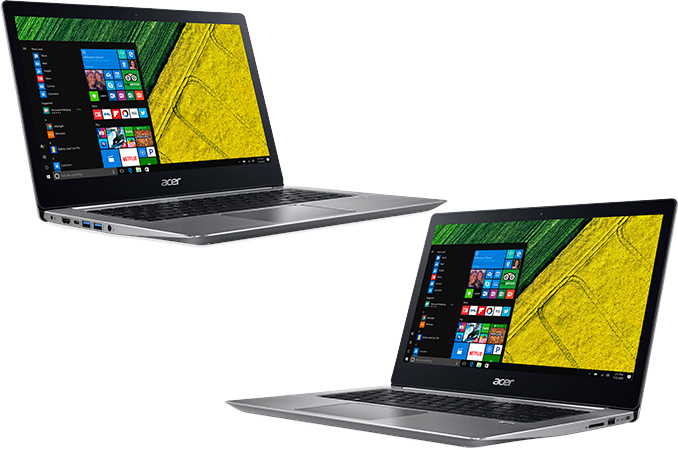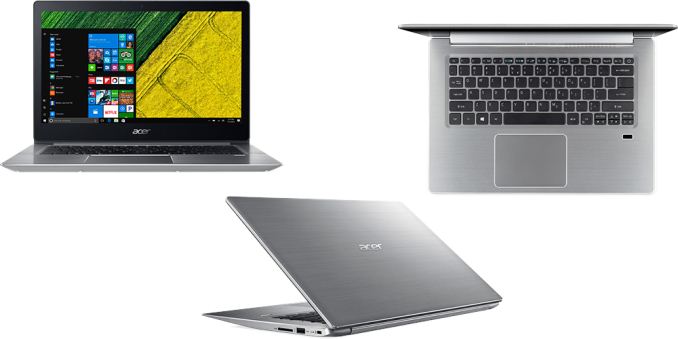More Ryzen Mobile: Acer Swift 3 with 2700U and 2500U Listed, From $750
by Anton Shilov on December 19, 2017 3:30 PM EST
Back at the Ryzen Mobile launch, AMD announced three primary partners with three devices: the HP Envy x360, the Acer Swift 3, and the Lenovo Ideapad 720S. At the time, only HP had some information available, and has since pushed the Envy x360 to retail. The other two have been surprisingly quiet about their models, but today Acer steps up to the plate with lists and pricing.
Acer has, without any fanfare, added two laptops powered by AMD’s Ryzen Mobile 2500U and Ryzen Mobile 2700U processors to its product lineup. The laptops have a metallic chassis, with a 15.6” IPS panel featuring a 1920x1080 resolution. Inside are AMD’s 15 W Ryzen Mobile APUs, the Ryzen 5 2500U and the Ryzen 7 2700U, each with four cores, eight threads, and Vega 8 (512SPs) or Vega 10 (640SPs) integrated graphics respectively.
The new systems have 8 GB of DDR4 memory, and storage comes in at either a 256 GB SSD or a 512 GB SSD (no word if SATA or PCIe). For connectivity, the AMD-powered Swift 3 uses an 802.11ac Wi-Fi + Bluetooth module, three USB Type-A ports, one USB Type-C header, and an HDMI output. Finally, the notebooks are equipped with a backlit keyboard, a webcam, two speakers and a microphone. The Acer Swift 3 design is one of a typical workhorse notebook, for consumers who demand to have decent performance and portability but do not necessarily need a portable workstation or an ultrabook. Interestingly the specification sheets say that the battery is listed as 3340 mAh, which at 17.4 volts makes around 58 Wh, although the voltage of the battery is not specified.
Back at the Ryzen Mobile launch, AMD stated that the chassis for the Swift 3 was designed to dissipate 25W at maximum, so by putting a 15W APU in there, it allows for a higher XFR boost frequency, as well as boosting for longer. The launch article also listed the DRAM being in dual channel operation, up to DDR4-2133. Acer confirms neither of these points, but dual-channel would be a good choke point to alleviate for the graphics - the DDR4-2133 is below the DDR4-2400 that the Ryzen APU platform supports, however.
By today’s standards, the Ryzen Mobile-based Swift 3 units can hardly be called thin or light — the device weighs around 2.2 kilograms and is 1.87 cm thick. Acer could have lower the weight by choosing plastic over metal for the chassis, but at the cost of rigidity, look and overall user experience. Meanwhile, being ultraportable is not the purpose of the vast majority of 15.6” laptops anyway. To Acer’s credit, it’s worth pointing out that the Ryzen Mobile-based Swift 3 are slightly thinner (but a bit heavier) than HP’s Envy x360 featuring the same APUs. We currently have the Intel-based Swift 3 units in for testing, so this would be an interesting counterpoint.
| Acer Swift 3 Laptops Based on AMD Ryzen Mobile APUs | ||||
| SF315-41-R8PP NX.GV7AA.003 |
SF315-41-R6J9 NX.GV7AA.004 |
|||
| Display | Diagonal | 15.6" | ||
| Resolution | 1920×1080 | |||
| Type | IPS | |||
| CPU | AMD Ryzen 5 2500U 4 Cores with SMT (8T) 2.0 GHz Base 3.8 GHz Turbo mXFR Support 2 MB L2 + 4 MB L3 Vega 8 iGPU 15 W |
AMD Ryzen 7 2700U 4 Cores with SMT (8T) 2.2 GHz Base 3.8 GHz Turbo mXFR Support 2 MB L2 + 4 MB L3 Vega 10 iGPU 15 W |
||
| Graphics | AMD Vega 8 512 stream processors 1100 MHz |
AMD Vega 10 640 stream processors 1300MHz |
||
| RAM | Capacity | 8 GB | ||
| Type | DDR4 (frequency unknown) | |||
| Storage | 256 GB SSD | 512 GB SSD | ||
| Wi-Fi | 802.11ac Wi-Fi module (unknown vendor) | |||
| Bluetooth | 4.x | |||
| USB | 2 × USB 3.0 Type-A 1 × USB 2.0 Type-A 1 × USB 3.0 Type-C |
|||
| Other I/O | HDMI 2.0a, webcam, TRRS connector for audio, speakers, microphone, SD card reader | |||
| Dimensions | Height | 18.8 mm | 0.74" | ||
| Width | 370.5 mm | 14.59" | |||
| Depth | 255 mm | 10.04" | |||
| Weight | 2.2 kg | 4.85 lb | |||
| Battery Capacity | 3320 mAh (58 Wh at 17.4V?) | |||
| Price | $750 | $950 | ||
Acer’s Swift 3 SF315-4-series notebooks are already listed on the company’s website, so expect them to be available commercially in the coming weeks. As for pricing, Acer's Taiwan site had the Swift 3 featuring the Ryzen Mobile 2500U and a 256 GB SSD listed at $750, whereas the more advanced Swift 3 featuring the Ryzen Mobile 2700U and a 512 GB drive was listed for $950 at retail.
Related Reading
Source: Liliputing













33 Comments
View All Comments
Sttm - Tuesday, December 19, 2017 - link
Are the Vega number properly indicative of performance? Is Vega 10 25% faster than Vega 8, and is Vega 64, 8 times faster?T1beriu - Tuesday, December 19, 2017 - link
Not really, no. The number represents the amount of compute units present.Dragonstongue - Tuesday, December 19, 2017 - link
Vega and the "number" is the shader clusters to my understanding, not exactly sure if these is a specific flat number that a vega 8 is X slower in a % fashion, takes much benchmarks to see this, and the "mobile" ones that have an upper TDP limited by the laptop or especially the "package" that is the cpu and gpu sharing X power, there will be some heat/throttle/power issues, so it makes it even more difficult IMO to say FOR SURE that Vega 8 is X % slower than Vega 10 .Laptop especially are extra "constrained" by the maker feeding it proper system memory, enough power and VERY MUCH proper cooling, something most laptop makers these days not seem to care much about.
Stuff it in as thin a chassis as possible, use the least amount of ram possible, slap on a fancy display, put the price as high as they feel is reasonable, they dont care if it bottlenecks or has overheat issues :D
Anyways, the shader cluster for Vega is 64
so vega 8 is 512/8=64 Vega 10 640/10=64, Vega 56 is 3584/56=64, Vega 64 is 4096/64=64
^.^
again, in a perfect world, put on a desktop with enough power/cooling etc, maybe you can reverse engineer that Vega 64 is X performance or X % faster than the "slowest" member which "should be" Vega 8 (by the amount of shaders) but, there is just way to many factors to do this, even something as "simple" as tuning the voltages can through these numbers out the door.
YMMV, but, when they (Vega mobile/Ryzen APU) currently are what 7w minimum to 35w maximum, it does not give a bunch of power/TDP headroom to run the cpu/gpu portions at their very best. anyways :D
olde94 - Tuesday, December 19, 2017 - link
8gb ram. AGAIN? o.O!MrSpadge - Tuesday, December 19, 2017 - link
8 GB is perfectly fine for most, especially given the current DRAM prices, and especially if 16 GB was offered as well.entity279 - Tuesday, December 19, 2017 - link
Except that it is likely it's a single stick. rip performanceTechnicallyLogic - Wednesday, December 20, 2017 - link
Nope, Dual Channel.TechnicallyLogic - Wednesday, December 20, 2017 - link
https://images.anandtech.com/doci/11964/amd_ryzen_...watzupken - Friday, December 22, 2017 - link
Normally 8GB is sufficient, but depends from each person's usage. Also you will need to factor in that the Vega integrated graphics shares 2GB of it from the 8GB pool, so leaving you with less when it comes to gaming.Alistair - Tuesday, December 19, 2017 - link
Ram is too expensive right now. Hope we see 16gb notebooks end of next year.